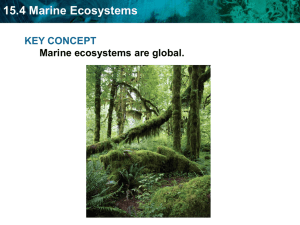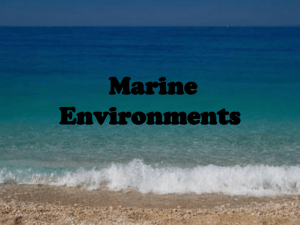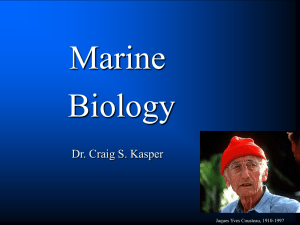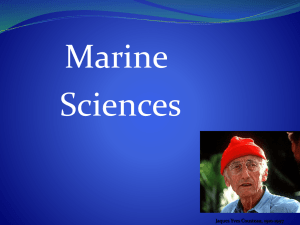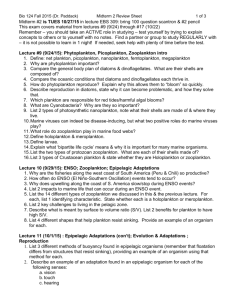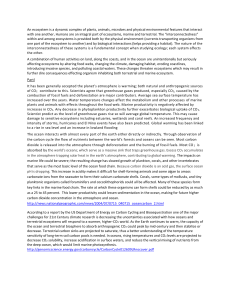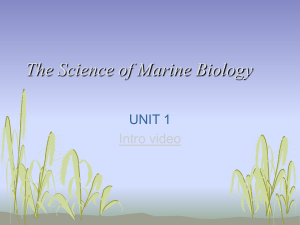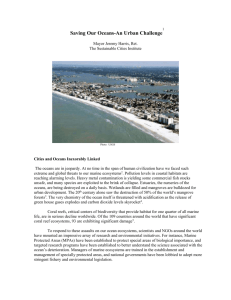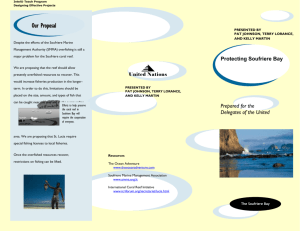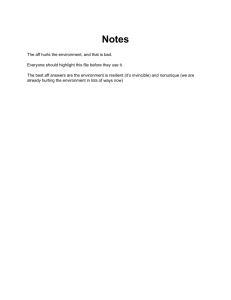Oceans on the Edge
advertisement
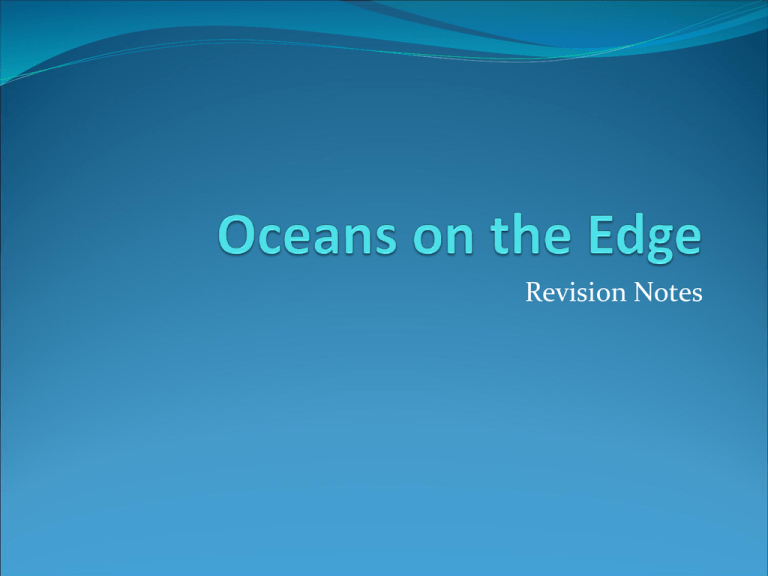
Revision Notes What you need to know 1. Threats to the ocean 2. Ecosystem change 3. Increasing exploitation 4. Sustainable management How and why are some ecosystems threatened with destruction? The term ecosystem describes a grouping of plants and animals that is linked with its local physical environment. The oceans, covering two-thirds of our planet, are home to marine ecosystem communities composed of fish, aquatic plants and sea birds- as well as tiny but very important organisms such as krill and plankton. HINT: make sure you are able to name some values of the Oceans e.g. its uses and value to human and animal life. Unsustainable Uses The way we use Oceans is becoming UNSUSTAINABLE this means we aren't treating/using it in a way that will preserve it for future generations. Within the oceans here is a natural balance between all life- these relationships form the FOOD WEB. It is also important to consider the NUTRIENT CYCLE which is the movement and re-use of important substances e.g., nitrogen. DISRUPTION’S TO FOOD WEBS the main three disruptions you need to understand are: 1. Overfishing 2. Eutrophication (caused by pollution) 3. Siltation (sedimentation) Climate Change Climate change also disrupts the oceans. Warmer Water • Fish in tropical seas could face famine • Food shortages then develop throughout entire food webs More acidic water and bleaching • Carbon dioxide dissolves in water to form carbonic acid • Small rises in acidity can seriously damage coral reefs, which then appear bleached after losing their vibrant colour Higher Sea Levels • Melting ice sheets on land masses will bring sea-level rises • Coastal marine ecosystems such as mangrove swamp or UK salt marshes would become permanently submerged and unique maritime communities might disappear altogether How should ecosystems be managed sustainably? There are three ways that marine ecosystems can be managed and that is again, as with the other units, at a LOCAL, REGIONAL and GLOBAL SCALE. Local Scale Managing coral reefs: Reefs are made of living animals, each piece contains polyp. They are part of a large colony of marine life. The polyp are skeletal creatures that form coral in clear, warm and sunlight seas. Coral reefs are home to ¼ of the world’s fish species. It also acts as natural barriers that protect the coastline from erosion. They are also great for tourism. However there are sustainability issues that come with this. Your case studies are the Great Barrier Reef, the Coral Triangle, and the Soufriere Marine Management Area Coral Reefs Under Threat The location of the SMMA, which stands for the Soufriere Marine Management Area is located in the town of Soufriere in the west coast of the Caribbean island of St.Lucia. The SMMA was formed in 1992 to protect the marine wildlife and reefs immediately surrounding the town. It brought together the following people, who would normally come into conflict: The local town council Local hotel owners Water-taxi owners Dive businesses Fishermen Marine managers Overall the SMMA has been successful as a model of sustainability. As a result, some of the best dive sites in the Caribbean are found in the waters of the SMMA. Result: Some problems – • the area has become so popular that the marine environment is threatened by mass tourism • rapid development in Soufriere encourages siltation and pollution But also positives – • the numbers, sizes and diversity of fish species has increased • many stakeholders are now involved in marine conservation Regional Scale: Managing the North Sea 1. Such as: 1. ensuring that the mesh of nets won’t catch undersized young fish 2. limiting the number of hours and days that fishing boats can operate each year 3. quota management 4. discard management 5. setting up marine reserves which protect all species 6. further research into how fishing affects the whole ecosystem The EU Common Fisheries Policy has tried to bring back fish stocks from catastrophically low levels in the North Sea. 2. Fishermen want as large a quota as possible but marine scientists argue that only ‘no fishing’ marine reserves will save species like the cod. But this is expensive as it means you have to pay fishermen not to fish! 3. Additionally, global warming is playing a part. Cold water species of plankton have been replaced by warm water species, changing the food available for baby cod. Furthermore, as the North Sea warms, cod will migrate to Arctic areas. Global Scale Global actions are needed to tackle pollution and to save threatened species from overfishing and extinction. International Organisations play a large role in ensuring that the oceans are protected. The United Nations Food and Agriculture Organisations regulates the management of deep sea fisheries. Other examples include IWC, UNCLOS and CITES (see next slide for more details) Individuals around the world can also ‘do their bit’ by changing their shopping habits to ensure that we only buy sustainably sources fish and buy ‘dolphin friendly’ tuna. (Think about what came out of your work on your DVDs) IWC: The International Whaling Convention was established in 1946 to oversee the management of the whaling industry worldwide. In 1986 it issued an indefinite ban on commercial whale hunting. UNCLOS: The United Nations Convention on the Law of the Sea addresses the main sources of ocean pollution – land based/coastal activities; continental shelf drilling for gas and oil; seabed mining; ocean dumping; and pollution from ships. CITES: The Convention on International Trade in Endangered Species of Wild Fauna and Flora gives global protection to all of the great whales Far More Difficult Problems To tackle on a global scale is the growth of the ‘Pacific Garbage Patches’. These are enormous rubbish-strewn regions of the north Pacific. The currents flow creates giant pools of ‘rubbish soup’. Practice Questions 1. Using examples, describe the threats facing marine ecosystems (6) Foundation 2. Using named examples, explain the short and long-term threats facing marine ecosystems (6) Higher 3. Describe the type of area a coral reef might be found (2) 4. How can an undisturbed coral reef support human activities? (2) 5. How could an increase in demand for one type of fish impact on the food chain? (6) 6. Explain how the change in ocean’s currents could impact marine ecosystems? (6) 7. Explain why the worlds oceans are under threat (4) 8. With reference to an example, explain the problems and successes of sustainable fishing (4)

